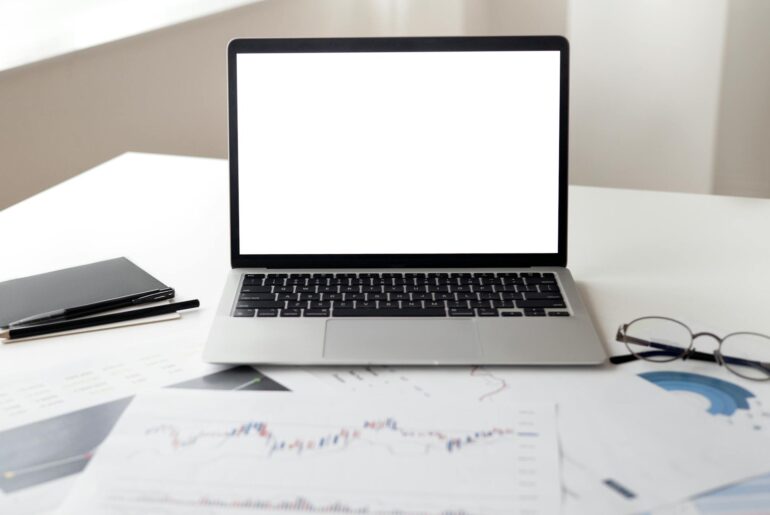This article may contain references to products or services from one or more of our advertisers or partners. We may receive compensation when you click on links to those products or services. Nonetheless, our opinions are our own.
The information presented in this article is accurate to the best of our knowledge at the time of publication. However, information is subject to change, and no guarantees are made about the continued accuracy or completeness of this content after its publication date.
Apple Stock in 2025
Apple Inc. (AAPL) has long occupied a prominent position among publicly traded companies, widely perceived as a symbol of stability and innovation. From sleek consumer electronics to a robust software ecosystem, its market footprint is hard to overlook. However, as investors enter the midpoint of 2025, there’s a quiet but growing question: Has Apple transitioned into a slower-growth phase, or does it still warrant a spot in modern investment portfolios? With recent analyst rating upgrades surfacing despite visible signs of deceleration across several revenue channels, investors are right to examine whether Apple is operating from strength or simply from reputation.
Where Apple Stands Today
Apple continues to maintain a position few corporations can rival. Its hardware, software, and services operate in tight coordination, allowing for recurring consumer engagement across devices and platforms. Still, this integrated model isn’t immune to fatigue. Recent financial reports indicate that while the company remains profitable and cash-rich, multiple segments of the business are cooling:
- iPhone revenue growth has slowed, especially in mature markets such as North America and Western Europe.
- Mac and iPad shipments have declined year-over-year, largely due to longer replacement cycles and muted consumer demand post-pandemic.
- Services revenue, once a reliable growth engine, has leveled off as competition in digital services intensifies.
Yet, despite these headwinds, Apple has not lost its allure among institutional and retail investors. The company’s operational discipline and product loyalty continue to underpin confidence.
Financial Profile
The mid-2025 outlook for Apple’s financial position reveals a company managing deceleration without falling into contraction. Investors should consider several indicators:
| Financial Indicator | Current Signal (2025) |
|---|---|
| Cash Reserves | ~$155 billion, stable and liquid |
| Free Cash Flow | Strong, though slightly down YoY |
| Gross Margin | Approximately 44.3%, maintaining strength |
| Dividend Yield | 0.56%, gradually increasing |
| R&D Spend | Trending upward, focused on AI/AR |
This financial structure gives Apple significant flexibility to invest, acquire, or weather broader economic uncertainty. The company’s strong balance sheet and continued share buyback programs also support price stability.
Voted "Best Overall Budgeting App" by Forbes and WSJ
Monarch Money helps you budget, track spending, set goals, and plan your financial future—all in one app.
Get 50% OFF your first year with code MONARCHVIP
Why Analysts Continue to Upgrade Apple Stock
Several major institutions have issued rating upgrades for Apple in Q2 2025, suggesting a cautiously optimistic outlook. These are not merely sentiment-based endorsements but responses to underlying strategic advantages that continue to attract long-term capital:
- Liquidity Strength: Apple’s war chest provides a strategic buffer against tightening economic conditions and funding challenges impacting the broader tech sector.
- Consistent Capital Returns: Apple remains committed to share repurchases and dividend increases, making it attractive for income-oriented investors.
- Product Pipeline Momentum: While unconfirmed, market speculation around augmented reality wearables and new AI-integrated products has contributed to forward-looking confidence.
Rather than being fueled by quarterly excitement, these upgrades seem rooted in Apple’s proven ability to manage transition periods without significant shareholder dilution or long-term brand erosion.
Investment Timing
Whether Apple represents an attractive investment right now depends on a variety of portfolio-specific variables, including investment horizon, income goals, and risk posture. However, the following entry conditions may be worth noting:
- Price dips not tied to deteriorating fundamentals may present attractive entry points for long-term investors.
- Positive earnings surprises or guidance revisions could signal a temporary or sustained reacceleration.
- Macroeconomic shifts that benefit high-cash, low-debt companies may tilt market sentiment further in Apple’s favor.
For many, Apple now belongs more in the category of consistent dividend payers and defensive growth than high-flying tech disruptors. This is not inherently negative; many portfolios benefit from durable, slow-growth equities.
Strategic Portfolio Considerations
Apple is far from the only large-cap tech firm competing for attention in 2025. For investors looking to balance exposure or hedge technology holdings, a few names provide potential alternatives:
| Company | Notable Strength |
|---|---|
| Microsoft | Enterprise dominance, particularly in cloud and AI services |
| Amazon | Logistics and cloud infrastructure scale via AWS |
| Nvidia | Demand leadership in GPU and AI computing hardware |
Each offers different risk profiles and growth vectors, allowing investors to fine-tune diversification across the sector without overconcentrating in any one narrative.
Rational Investing
In an environment where stock movements can be heavily influenced by news cycles, sentiment, or social media buzz, staying objective remains a foundational principle of successful investing. Apple’s stock may experience fluctuations tied more to perception than to material changes in value. To maintain a measured approach:
- Focus on multi-quarter performance, not week-to-week volatility
- Monitor shifts in capital expenditures, product strategy, and unit economics
- Review earnings calls and investor updates for signs of operational pivots or restructuring
Emotional investing, especially when dealing with a household name, often leads to poor timing and missed opportunities.
Is Apple Still a Sensible Buy?
By mid-2025, Apple may no longer offer the explosive growth story it did a decade ago. However, the company still demonstrates characteristics investors prize: durable demand, fiscal conservatism, disciplined management, and capital return strength. It’s reasonable to think of Apple as a resilient holding, especially in portfolios that benefit from blue-chip exposure and dividend stability. While risk-adjusted returns may be lower than those of emerging tech firms, Apple still plays a valuable role in preserving value and providing modest, steady appreciation. Investors seeking an aggressive growth thesis may find more compelling opportunities elsewhere. But for those focused on high-quality equities with proven governance and strategic discipline, Apple remains very much in the conversation.
Frequently Asked Questions
What challenges is Apple facing in 2025?
Apple is contending with slower iPhone sales growth, tightening service segment margins, and broader macroeconomic pressures impacting consumer electronics demand. The company is going through these issues through increased investment in AI and hardware innovation.
Why has Apple received rating upgrades despite softening revenue?
Analysts are focusing on Apple’s financial resilience, including its large cash position, stable margins, and consistent capital return programs. Anticipated product developments also factor into these upgrades.
Is Apple still appropriate for long-term investors?
Yes, particularly for investors who prioritize capital preservation, consistent dividends, and exposure to large-cap technology. Apple’s business remains profitable, and its global brand equity continues to generate strong retention metrics.
What could reignite Apple’s growth in the future?
New product categories, such as augmented reality devices or expanded AI integration in its existing ecosystem, could spur renewed top-line growth. Strategic acquisitions and enhanced monetization of services are also areas to watch.
Are there better alternatives to Apple in the tech sector?
Depending on your objectives, companies like Microsoft, Nvidia, or Amazon may offer higher growth prospects or more exposure to disruptive technologies. Portfolio construction should balance exposure based on risk and sector allocation goals.

Reviewed and edited by Albert Fang.
See a typo or want to suggest an edit/revision to the content? Use the contact us form to provide feedback.
At FangWallet, we value editorial integrity and open collaboration in curating quality content for readers to enjoy. Much appreciated for the assist.
Did you like our article and find it insightful? We encourage sharing the article link with family and friends to benefit as well - better yet, sharing on social media. Thank you for the support! 🍉
Article Title: Is Apple Still a Smart Buy? Evaluating Risks and Opportunities in 2025
https://fangwallet.com/2025/06/26/is-apple-still-a-smart-buy-evaluating-risks-and-opportunities-in-2025/The FangWallet Promise
FangWallet is an editorially independent resource - founded on breaking down challenging financial concepts for anyone to understand since 2014. While we adhere to editorial integrity, note that this post may contain references to products from our partners.
The FangWallet promise is always to have your best interest in mind and be transparent and honest about the financial picture.
Become an Insider

Subscribe to get a free daily budget planner printable to help get your money on track!
Make passive money the right way. No spam.
Editorial Disclaimer: The editorial content on this page is not provided by any of the companies mentioned. The opinions expressed here are the author's alone.
The content of this website is for informational purposes only and does not represent investment advice, or an offer or solicitation to buy or sell any security, investment, or product. Investors are encouraged to do their own due diligence, and, if necessary, consult professional advising before making any investment decisions. Investing involves a high degree of risk, and financial losses may occur including the potential loss of principal.
Source Citation References:
+ Inspo
Apple Inc. (2025, May 1). Current report on Form 8‑K: March quarter performance [Press release]. U.S. Securities and Exchange Commission.













































